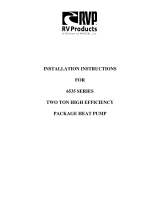
13
e. Heat Pump - On heat pump models the #7 dip
switch is in the "ON" position from the factory.
Non heat pump models leave in the "OFF"
position.
f. Furnace - If a Furnace/Aqua heat system has
been connected to this unit, the furnace dip
switch must be placed in the “ON” position.
g. Dehumidify - Dehumidify is not used on this
unit. Leave in the “OFF” position.
h. Gen start selection - Leave in the “OFF” posi-
tion.
i. Replace the unit electrical box cover and out
side plastic shroud.
j. Repeat this procedure for each additional
zone.
a. Each CCC thermostat can have up to 4 zones.
When only one unit is installed it becomes
Zone 1 and no dip switch setting is required.
Each additional unit must be assigned a zone
(2 through 4). Each unit must have a different
zone setting.
b. Heat strip selection - On heat strip models
the #1 dip switch is in the "ON" position from
the factory. Non heat strip models leave in
the "OFF" position.
c. Furnace selection - when a furnace has been
connected to a zone, place the furnace dip
switch “ON” for that zone.
d. Differential - differential is the temperature
difference between the “ON/OFF” cycle of
the thermostat in the furnace mode. The nor-
mal differential is preset in the circuit board
with the dip switch set to the “OFF” position.
In some situations, it may be necessary to
decrease the differential. The location of the
thermostat may create a condition where the
normal differential will not maintain your com-
fort zone. If this occurs, the differential can
be shortened by placing the differential dip
switch to the “ON” position.
Note: Setting the differential dip switch should only be re-
quired when installation conditions are less than desirable
and is not covered under the limited warranty.
e. Stage selection - stage is not used on these
units. Leave in the “OFF” position.
f. Gen start selection - leave in the “OFF” posi-
tion.
g. Replace the unit electrical box cover.
h. Repeat this procedure for each additional
zone
a. Ext. Stage - Ext. Stage is not used on this unit.
Leave in the “OFF” position.
b. Zone selection - Each CCC 2 thermostat can
have up to 4 zones. When only one unit is
installed it becomes Zone 1 and no dip switch
setting is required. Each additional unit must
be assigned a zone (2 through 4). Each unit
must have a different zone setting.
c. Stage selection - Stage is not used on this unit.
Leave in the “OFF” position.
d. Heat Strip - On heat strip models the #6 dip
switch is in the "ON" position from the factory.
Non heat strip models leave in the "OFF"
position.
On Position
Off Position
FIG. 23
CCC Dip Switch Selection
CCC 2 Dip Switch Selection
2. System Reset
a. CCC system
After setting the dip switches in the electronic
control, do a system reset.
i. Turn the ON/OFF switch to the “OFF”
position.
ii. Simultaneously press and hold the
MODE and ZONE push-buttons while
turning the ON/OFF switch to “ON”.
FF should appear in LCD display un-
til the mode and zone push-buttons are
released.
iii. When a dip switch is turned on after initial
conguration, a system reset will need to
be done before the CCC thermostat will
recognize the updated selection.
b. CCC 2 system
After setting the dip switches in the electronic
control, do a system reset.
i. Reconnect the 12 VDC and 120 VAC power
supplies.
ii. Make sure the CCC 2 thermostat is in the
“OFF” mode.
iii. Simultaneously press the MODE and
ZONE buttons. The LCD will display “IniT”
and all available zones.
iv. Release the MODE and ZONE buttons.
v. Press the ON/OFF button to exit system
set up.
vi. When a dip switch is turned on after initial
conguration, a system reset will need to
be done before the CCC 2 thermostat will
recognize the updated selection.
3. System Checkout
Verify that all features of the installed system work.
See CCC and CCC 2 thermostat Operating Instruc-
tions or User’s Guide. Reconnect the 12 VDC and
120 VAC power supplies. Check fan speeds, cool-
ing mode, heat pump mode, and furnace mode (if
connected). If the features do not work disconnect
the 12 VDC and 120 VAC power supplies and
verify that all wiring is correct and that the correct
dip switches have been turned on.





















